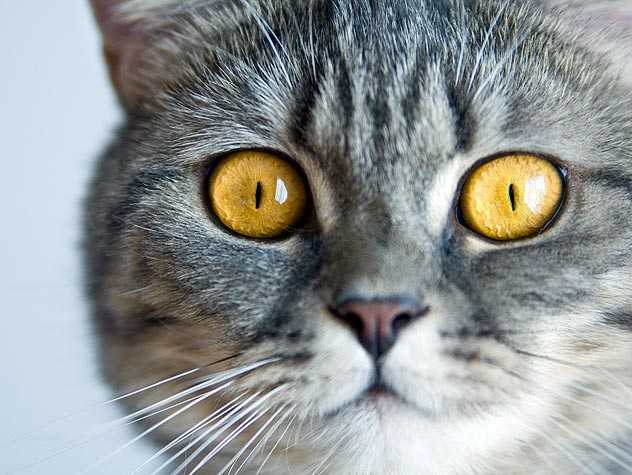Thyroid Disease and Cats

In the early 1990s, a client came in with her 12-year-old male cat, Lester. She told me that Lester had been tentatively diagnosed with liver disease, and that her veterinarian was trying to talk her into having a liver biopsy performed to further characterize the disease. Reluctant to put Lester through a surgical procedure, the owner wanted a second opinion. The cat's recent bloodwork showed a normal CBC (complete blood count) and urinalysis, but elevations of several liver parameters.
Lester was a very thin, bony, unkempt little cat. When I asked about his appetite, his owner said, "His appetite is the reason I brought him to the vet in the first place!" When she explained that Lester was losing weight, even though he was eating like a pig, I immediately suspected hyperthyroidism.
Making the Diagnosis
Hyperthyroidism is the most common glandular disorder in cats. It is most frequently caused by an excessive concentration of circulating thyroxine - a thyroid hormone better known as T4 - in the bloodstream. Hyperthyroidism can occur in any breed of cat, male or female, but occurs almost exclusively in older animals. Less than 6 percent of cases are younger than 10 years of age; the average age at onset is between 12 and 13 years.
Weight loss and increased appetite are among the most common clinical signs of this condition. Weight loss is seen in 95 percent to 98 percent of hyperthyroid cats and a hearty appetite in 67 percent to 81 percent. Excessive thirst, increased urination, hyperactivity, unkempt appearance, panting, diarrhea and increased shedding have also been reported. Vomiting is seen in about 50 percent of affected cats. Clinical signs are a result of the effect of increased T4 levels on various organ systems.
Because several common diseases of older cats - diabetes, inflammatory bowel disease, intestinal cancer and chronic kidney failure - share some of the clinical signs of hyperthyroidism, a battery of tests is in order. A CBC, chemistry panel and urinalysis alone will not diagnose hyperthyroidism, but they can certainly rule out diabetes and kidney failure. Hyperthyroid cats may have normal findings on the CBC and urinalysis, but the chemistry panel often shows elevation of several liver enzymes. In the vast majority of cases, a definitive diagnosis of hyperthyroidism is based on a simple blood test that shows elevated T4 levels in the bloodstream. Lester's initial veterinarian neglected to perform this test, and elevated liver enzymes led him to misdiagnose liver disease.
Unfortunately, between 2 percent and 10 percent of cats with hyperthyroidism will have normal T4 levels. One possible explanation for this is that in mild cases, T4 levels can fluctuate in and out of the normal range. Another is that concurrent illness will suppress elevated T4 levels, lowering them into the normal or high-normal range and fooling the veterinarian into thinking that the cat's thyroid status is normal. Because these are geriatric cats, concurrent illness is fairly common, and diagnosis of hyperthyroidism in these cats can be tricky.
Treating the Cat
Several treatment options for hyperthyroidism exist, each with advantages and disadvantages.
- Oral administration of antithyroid medication. Methimazole (brand name Tapazole™) has long been the mainstay of drug therapy for feline hyperthyroidism. It is highly effective in correcting the condition, often within two to three weeks. Unfortunately, about 15 percent to 20 percent of cats will suffer side effects, such as loss of appetite, vomiting, lethargy, blood clotting problems, jaundice, itching around the head and face and, occasionally, blood cell abnormalities. Most side effects are mild and eventually resolve, although some necessitate discontinuation of the medication. Lifelong daily medication is required, which is a disadvantage to owners whose cats resist pilling. CBC and T4 levels need to be rechecked regularly for the remainder of the cat's life.
- Surgical removal of the thyroid gland. Hyperthyroidism is usually caused by a benign tumor called a thyroid adenoma that involves one or, more often, both thyroid glands. Fortunately, most hyperthyroid cats have benign, well-encapsulated tumors that are easily removed. Surgery usually results in a cure, but anesthesia can be challenging in these older patients whose disease may have affected their hearts and other organs. Although surgery may seem costly, it often ends up being less expensive than years of oral medication and regular bloodwork rechecks.
- Radioactive iodine therapy. This is the best and most sophisticated treatment option. Radioactive iodine, given by injection (usually under the skin) becomes concentrated in the thyroid gland, where it irradiates and destroys the hyperfunctioning tissue. No anesthesia or surgery is required, and only one treatment is usually needed to achieve a cure. It used to be that radioiodine treatment was performed only in specialized, licensed facilities, but many private treatment facilities are now found throughout the country. Hospitalization may be prolonged; depending on local or state ordinances, cats may need to be kept at the treatment facility for 10 to 14 days until the level of radioactivity in their urine and feces decreases to an acceptable level. Also, radioiodine therapy is costly. The price tag has come down from about $1,200 to between $500 and $800 - but this is still prohibitive for many cat owners.
As for Lester, his circulating T4 level was extraordinarily high. Because the cat was only 12 at the time of diagnosis, and his owner was not keen on giving him a pill twice a day for the rest of his life, she opted for surgical removal of the thyroid gland. Lester's surgery was without incident, and all of his clinical signs resolved over several days.
Dr. Plotnick is vice president of Bergh Memorial Animal Hospital.
Courtesy of
ASPCA
424 East 92nd St.
New York, NY 10128-6804
(212) 876-7700
www.aspca.org